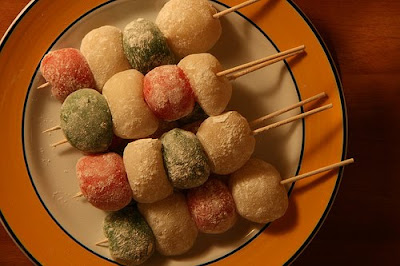
Wagashi, a traditional Japanese confectionery, served with green tea ,is made from natural ingreidents. Its meaning of name is natural beauty from the ancient literature. Wagashi has been popular for many decades.
Wagashi has various kinds of itself; you can enjoy most of it during the whole year---spring, summer, fall and winter.Here are some types of it.
The first, Anmitsu, has two kinds.
Anmitsu is made of cube of agar jelly, red algae, seaweed and peas, peach slices, pineapple and cherries. The final addition is black syrup.
Anmitsu is made of cube of agar jelly, red algae, seaweed and peas, peach slices, pineapple and cherries. The final addition is black syrup.
(1)Mitsumane---without red bean paste
(2) Cream Anmitsu---ice cream is on top of it.
Amanatto: its basic materials are red beans, refined sugar and syrup.


Botamochi: materials---red bean paste, rice flour, or other prowder, like peanut prowder---must be prepared in advance. Its production is springtime.
Dango: it is a kinds of dumplings, made of mochi and rice flour, served with green tea.
Bocchan Dango:there are three colors about it. The color green is made from green tea; the white, eggs; while, the red is red beans.
Chichi Dango: its materials are simple. They are rice flour and pigments of diferent colors.
Ikinari Dango:it is a steamed bun with chunks of sweet potato in the drought, its center is red bean paste. It is the local confectionery in Kumamoto.
1. confectionery: sweets/candy, chocolate, etc.
2.agar:a type of fungus with a large top, that looks like a mushroom.
3.syrup:any thick sweet liquid made with sugar, used especially as a sauce.
4.chunk:a fairly large amount of something.
5.pigment:a substance that exists naturally in people, animals and plants and gives their skin, leaves, etc. a particular colour.


















